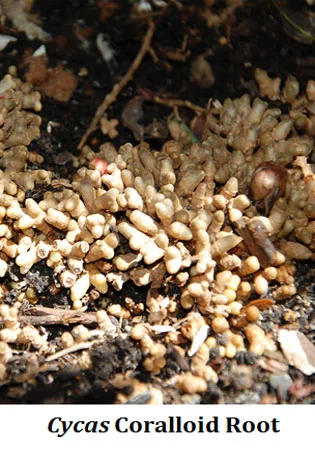Part – 1: Morphology of Cycas
<<< Part 0 — Part 2 >>>
Systematic Position (Sporne, 155)
Division: Gymnosperms
Class: Cycadopsida
Order: Cycadales
Family: Cycadaceae

Distribution of Cycas
Ø Cycas belongs to an ancient plant group called Cycadophyta of the Division Gymnosperms
Ø Cycadophyta were the major vegetation of Jurassic and Cretaceous periods.
Ø The genus Cycas is the only living genera of the family Cycadaceae.
Ø Cycas genus consists of about 113 species.
Ø Plants shows typical Xerophytic Adaptations.
Ø There are both Wild and Cultivated species of Cycas.
Ø Cycas is mainly distributed in Tropical and Sub-tropical regions
Ø In India: ~ 9 species of Cycas are reported
Ø Important Indian species of Cycas : Cycas circinalis, C. revolute, C. annaikalensis, C. beddomei, C. indica, C. zeylanica etc.
Ø Cycas circinalis is endemic to India, It is the first described species of Cycas (Type genus)

Ø Cycas annaikalensis is critically endangered and endemic species of Cycas present in the Annaikal Hills of Palakkad, Kerala
You may also like: Cycas PPT (Download)
Morphology of Cycas
Ø Sprophyte is the prominent generation in the life cycle of Cycas, which is differentiated into root, stem and leaves.
Ø Cycas is an evergreen plant.
Ø All living Cycas species are dioecious (male and female plants are separate).
Ø Palm like appearance, having a cylindrical stem with a crow of leaves at the apex.
Morphology of Stem
Ø Stem (caudex) is cylindrical and erect.
Ø Stem surface is covered by leaf scars.

Ø Usually the stem un-branched, sometimes branched
Ø The branching occurs due to the wound-healing activity of the stem.

Ø The growth rate of the plant is very slow.
Ø Cycas live for many years.
Ø New leaves are produced as crown in each growing seasons.
Ø Stem covered with persistent leaf bases.
Ø Stem undergo secondary thickening.

Morphology of Leaves
Ø Leaves are produced as crown on the apical portion of the stem.
Ø Leaves are produced as a bunch.
Ø Leaves are pinnately compound and frond-like (like the leaves of Pteridophytes)
Ø Young leaves of Cycas shows circinate vernation.
Ø Circinate vernation: Young leaves are curved inward, a character of ferns

Ø Cycas plants produce TWO types of leaves
(1). Scale Leaves
(2). Foliage Leaves
(1). Scale leaves
Ø Scale leaves are small, scaly and brown in colour
Ø The brown colour is due to the presence of ramental hairs.
Ø These leaves are non-photosynthetic leaves.
Ø Function: Protection of younger parts

(2). Foliage leaves
Ø Foliage leaves are large and pinnately compound
Ø Consists of a long rachis with many laterally placed leaflets
Ø They are green coloured and hence photosynthetic.
Ø Foliage leaves shows circinate vernation
Ø Function: Perform photosynthesis
Ø The crown of scale leaves and foliage leaves are produced alternatively.
Morphology of Roots
Ø Cycas possess TWO types of roots
(1). Tap-root
(2). Coralloid Root
(1). Tap-root
Ø The primary root (root developed from the radicle of embryo) forms the tap-root in Cycas.
Ø The tap root is less branched
Ø They are positively geostrophic and grow downward.
Ø They undergo secondary thickening
Ø Function: Anchorage and absorption of water and minerals from the soil
| You may also like NOTES in... | ||
|---|---|---|
| BOTANY | BIOCHEMISTRY | MOL. BIOLOGY |
| ZOOLOGY | MICROBIOLOGY | BIOSTATISTICS |
| ECOLOGY | IMMUNOLOGY | BIOTECHNOLOGY |
| GENETICS | EMBRYOLOGY | PHYSIOLOGY |
| EVOLUTION | BIOPHYSICS | BIOINFORMATICS |
(2). Coralloid roots
Ø Coralloid roots are a special type of root present in Cycas.
Ø They are developed from the normal roots.
Ø They are highly branched roots.
Ø They are negatively geostrophic (grown up-ward).

Ø They have Coral like appearance due to the severe branching.
Ø They possess nitrogen fixing algae in its cortex.
Ø Coralloid roots helps in nitrogen fixation.
Ø Usually secondary thickening is absent in coralloid roots.
<<< Gymnosperms Notes | Cycas Part 2: Anatomy of Stem >>>
| You may also like... | ||
|---|---|---|
| NOTES | QUESTION BANK | COMPETITIVE EXAMS. |
| PPTs | UNIVERSITY EXAMS | DIFFERENCE BETWEEN.. |
| MCQs | PLUS ONE BIOLOGY | NEWS & JOBS |
| MOCK TESTS | PLUS TWO BIOLOGY | PRACTICAL |
